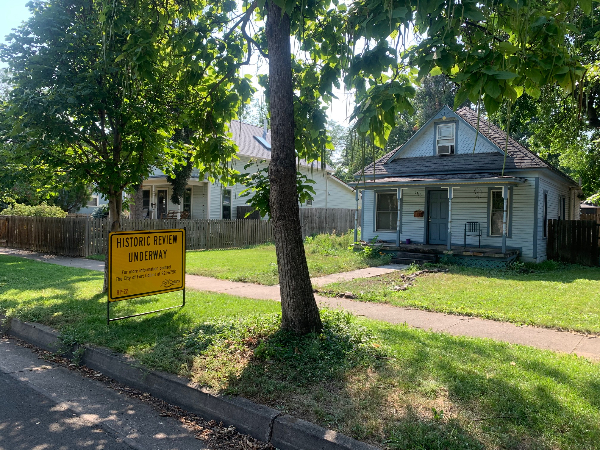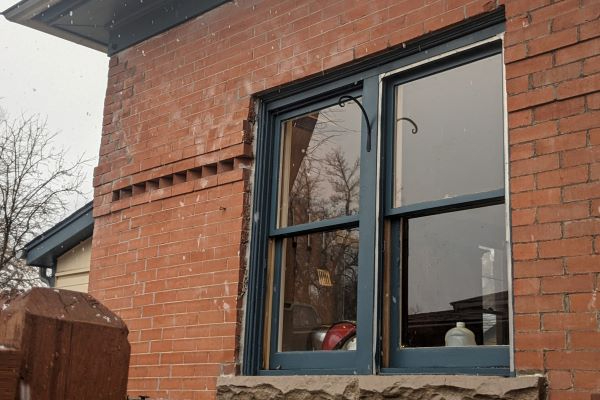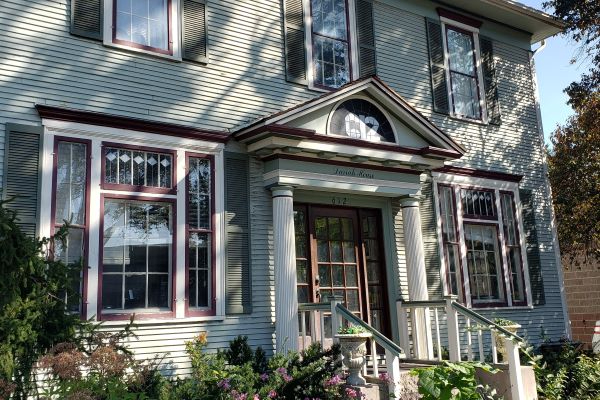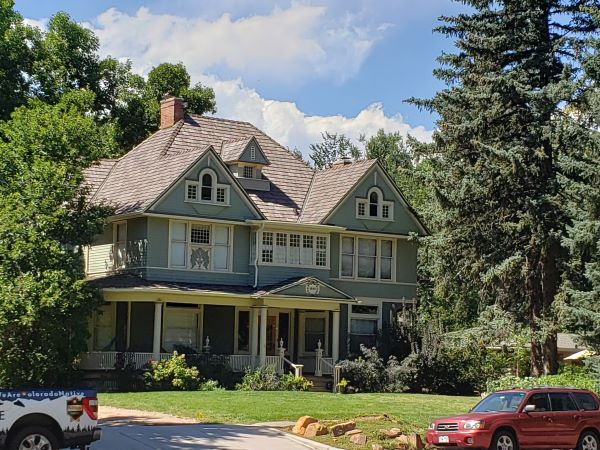Design Review#
Recent Design Review Decisions
Please click HERE for a list of the recent design review decisions from Historic Preservation staff and the Historic Preservation Commission (HPC).
What Is Design Review, and Why Does It Happen?#

Historic preservation is the process of connecting history, culture, and heritage to a place and telling that place's story. That requires the preservation of key physical features of buildings, sites, and landscapes so that place can continue telling its story - that's what design review is all about.
The design review process exists to prevent the loss of, or damage to, Fort Collins' significant historic resources, preserve our city's unique history, realize the environmental benefits of reusing our existing building stock, and help property owners take advantage of financial incentives available for eligible historic resources, including tax credits and zero-interest loans.
Through the design review process, all exterior alterations to designated resources in Fort Collins are approved or denied based on the historic significance and character of the property. The review process is outlined in Chapter 14, Article IV of the Fort Collins Municipal Code and Land Use Code Article 5 Division 5, Historic (p. 5-53, PDF p. 57).
Is Design Review Required for My Property?#
Historic preservation design review is required for:
Fort Collins Historic Landmarks and Landmark Districts (the most protected)
- Certificate of Appropriateness is required before exterior work can begin.
- Work must meet the Secretary of the Interior's Standards for the Treatment of Historic Properties (the Standards).
National Register of Historic Places & Colorado State Register (protection encouraged; sometimes required)
- Report under Article IV required before work can proceed. Report documents whether project meets the Standards.
- It is recommended that work meet SOI Standards to retain listing and access to financial incentives.
- For owners of single-family residences listed in the National or State Registers, compliance with the Standards is not required, although work cannot begin until a report is issued by the City's Historic Preservation Staff or Historic Preservation Commission.
- Note: work completed on these kinds of historic buildings that does not meet the Standards may endanger the historic status of the building and lead to permanent loss of access to historic preservation incentives for the property.
Multi-family residential and commercial properties that are designated as historic OR eligible for Landmark designation
- Compliance with the Standards is required and a Certificate of Appropriateness must be issued per the requirements of Land Use Code Article 5 Division 5, Historic (p. 5-53, PDF p. 57).
When Should I Start This Process?#
If you own a designated resource, you are required to have all exterior work reviewed and approved by either City historic preservation staff or the Landmark Preservation Commission before you start work on the project or be approved for a building permit. Staff recommends that you work closely with us from the idea stage through completion of the project. This will help ensure that the idea you have comes to reality in a way that fits your needs and meets the Secretary of the Interior's Standards.
It is never to early to contact staff to get the process started, even if you aren't quite ready to fill out an application. You can reach us at preservation@fcgov.com or 970-416-4250.
How Do I Apply for Design Review?#
Design Review begins when an application is received for a project. Some minor/routine projects may not need an application (e.g., in-kind roof replacement), so please check with staff at preservation@fcgov.com or 970-224-6078 if you're not sure.
- Design Review Application: Fill out this PDF and return to staff at preservation@fcgov.com with photographs and any other accompanying information (project plans, product sheets, etc.).
- Extra Design Review Worksheet: If you need more room to discuss your project, or have more items to request review for, use this extra worksheet.
Who Does the Review?#
Historic preservation design review is usually completed by City staff, who are trained specialists in historic preservation. In cases where a project is large, complex, is not meeting the Standards, or is being appealed, review will be completed by the City's Historic Preservation Commission.
Staff Review Process#
Most projects are able to be reviewed at a staff level. Those projects are usually routine in nature, very minimally effect the historic integrity of the property, or very clearly meet the Secretary of the Interior's Standards for the Treatment of Historic Properties. After staff receives an application, they will be able to let you know if it is eligible for staff level review only.
Staff review means that the application can be reviewed internally without going before the Historic Preservation Commission. Staff review is generally quicker than going before the HPC, but will still be reviewed with the same rigor and adherence to the Standards.
Historic Preservation Commission Review Process#
Although City staff reviews most projects, some, including large projects, may go to the Historic Preservation Commission (HPC) for review instead. All projects reviewed by the HPC go through at least one hearing, but applicants going before the HPC are encouraged to complete a conceptual public hearing with the Commission prior to submitting final project plans for approval.
The HPC's meeting schedule can be found online, here. Materials are typically due from applicants the Monday two weeks in advance of the meeting (usually twelve business days in advance).
Public Hearing - Conceptual (Optional, but strongly recommended)
This is an opportunity for the applicant to discuss requirements, standards, design issues and policies that apply to designated historic resources prior to beginning work. Problems can be identified and solved prior to final review of the application. Conceptual review of any proposed work may be limited to certain portions of the work as deemed appropriate by the Commission. If, upon review of the proposed work, the Commission determines that conceptual review is not necessary given the absence of a significant impact on the landmark or landmark district involved, it may be waived by the Commission, and the Commission may then proceed to consider the proposed work on final review at the same meeting.
Public Hearing - Final
Each application shall be finally reviewed and approved by the Commission at the same meeting as the Commission's conceptual review of the application, if any, or at a subsequent meeting of the Commission. During final review, the Commission shall consider the application and any changes made by the applicant since conceptual review.
Guidance for Common Projects#
Window Alterations#

Windows are often a character-defining feature of historic properties. To conform with the Secretary of the Interior's Standards for the Treatment of Historic Properties, Fort Collins's adopted preservation standards, existing windows should be rehabilitated rather than replaced in order to conserve the durable and character-defining historic materials, except in cases where materials are too deteriorated to repair. In some circumstances, however, the window type or form is more important than the material type to the stewardship of a historic building; for instance, buildings constructed after 1950 often used less durable window materials, such as aluminum or vinyl, and so replacing windows with new units of a matching form would be an acceptable alteration.
Energy efficiency of historic windows can often be increased without replacement. Egress windows can also often be installed in existing or new window openings in a way that maintains the character of a historic building. Contact preservation@fcgov.com if you are planning a window project for your historic property for project guidance and connection to financial resources, if applicable. Building permits are also required for window and door replacements - See guidance from the Building Department here.
Painting#

If your property is designated as historic, all exterior alterations need to be reviewed for compliance with preservation standards - That includes paint! Colors are not generally regulated, but color choices should generally highlight architectural features or woodwork rather than distract from them or diminish their visibility. For wood surfaces, oil-based primers and oil-based paints or highly vapor permeable latex paints are generally recommended. Latex/water-based paint should not be applied directly to oil-based paint, or peeling can occur. Unpainted masonry should not be painted - Paint can trap water inside of a brick or stone wall and cause serious damage.
Landscaping#

Landscaping usually doesn’t need a Certificate of Appropriateness (approval from Historic Preservation) and Historic Preservation Services generally supports xeriscaping, tree-planting, and other landscaping treatments that support social and environmental resiliency. However, in some cases, a landscaping project may need historic preservation review to confirm that it won’t damage important historic features of a particular historic place. Here’s a list of common projects that should contact Historic Preservation Services for approval:
- Addition or removal of trees – Historic trees should be replaced in-kind (same or similar species match, in a similar location); new trees should be located fifteen feet or more from historic structures to avoid structural damage to the structure as the tree matures. (Please note that the City frequently requires that work on trees be completed by a certified arborist. For more information, contact the City’s Forestry division, HERE).
- Addition or removal of fences – Historic fences should be retained/repaired, and new fences on a front yard should be at or below four feet in height and generally be of wood or metal configuration that preserves open views from the sidewalk to the front of the property. Privacy fences along rear yards are typically allowable.
- Addition or removal of small structures (gazebos, etc.) – Historic features generally must be retained, and new features should be added where they will have reduced visibility (i.e., a rear yard). New landscape features like walls, seating areas, terracing, etc., should not obstruct views of an historic building or feature from the public sidewalk.
Most other types of common modifications do not need Historic Preservation review, including changes to a planting plan (except trees, as noted above), xeriscaping, additions of rock gardens, installation of rain gardens, installation of erosion control features, landscaping to channel water away from a building/structure foundation, adding minor landscape features like mailboxes, small yard signs, etc.) etc. If you’re unsure of whether your project needs review, contact us at preservation@fcgov.com or 970-224-6078 and we’ll let you know.
Solar Panels on Historic Buildings#
In April 2024, the City's Historic Preservation Commission approved a new set of standards for rooftop solar installations on historic buildings. While less-visible installations are still encouraged, the new policy does several things:
- Shifts most rooftop solar installations on historic buildings to a faster staff review, assuming panels meet design requirements like being flush-mounted, etc.;
- Outlines specific installation constraints to avoid shielding or obscuring important historic features of historic properties;
- Allows rooftop solar to be visible, although street-facing installations must show the absence of an alternative location prior in order to receive approval.
This policy was adopted specifically respond to the City's Our Climate Future Plan, but also follows the guidance of the Advisory Council on Historic Preservation to adapt historic preservation treatments to better respond to current climate action and social equity needs.
Roofing on Historic Buildings#
The Boughton House at 113 N. Sherwood St., with historic wood shingles replaced with new synthetic TPO panels replicating the historic wood.
On November 20, 2024, the City's Historic Preservation Commission approved a policy to add flexibility to the roofing solutions available to historic property owners. Roofing is an essential component to a healthy building, historic or not, and having adequate roofing on historic buildings ensures they're historic materials and features will survive for future generations to enjoy. This new policy achieves the following:
- Encourages climate resilience in hail-prone Fort Collins by allowing for the use of newer, more durable, and more fire-resistant roofing options such as stone-coated metal and TPO-membrane panels.
- Supports waste-diversion by allowing roofing products with a more reliable market for recycling.
- Defines provisions for roof-related features like vents, gutters, downspouts, and insulation, including allowing for the addition of up to six (6) inches in roof height for above-deck insulation.
This policy was adopted specifically to respond to the City's Our Climate Future plan as well as to support the call to action in the Advisory Council on Historic Preservation's 2024 report on interpreting the federal preservation treatment standards with climate action and social equity in mind.
Planning a Different Type of Project?#
If you're planning a different type of project, or if you'd like some guidance more specific to your proposed project, don't hesitate to reach out to Historic Preservation Services staff at preservation@fcgov.com, by calling 970-224-6078. We would be happy to help you by phone or email, or you can contact us to make an appointment for an in-person meeting at our office at 281 N. College Ave.
| HPC Meeting Month (2025) | Application Deadline | Work Session | Regular Meeting |
|---|---|---|---|
| January | Mon., Dec. 23 | Wed., Jan. 8 | Wed., Jan. 15 |
| February | Mon., Jan. 27 | Wed., Feb. 12 | Wed., Feb. 19 |
| March | Mon., Feb. 24 | Wed., Mar. 12 | None |
| April | Mon., March 24 | Wed., April 9 | Wed., April 16 |
| May | Mon., April 28 | Wed., May 14 | Wed., May 21 |
| June | Mon., May 26 | Wed., June 11 | Wed., June 18 |
| July | Mon., June 23 | Wed., July 9 | Wed., July 16 |
| August | Mon., July 28 | Wed., Aug 13 | Wed., Aug 20 |
| September | Mon., Aug. 25 | Wed., Sept. 10 | Wed., Sept. 17 |
| October | Mon., Sept. 22 | Wed., Oct. 8 | Wed., Oct. 15 |
| November | Mon., Oct. 27 | Wed., Nov. 12 | Wed., Nov. 19 |
| December | Mon., Nov. 24 | Wed., Dec. 10 | Wed., Dec. 17 |

